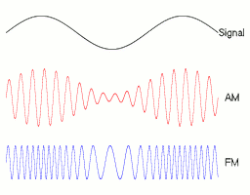For young people, probably born before 2000 (1995?) the idea of AM radio is something they really don't know about. Even in the car, most people don't listen to AM radio any more. The audio quality is much lower on AM than on FM.
AM stands for Amplitude Modulation, FM stands for Frequency Modulation. The modulation has to do with converting a radio frequency carrier into sound. Amplitude Modulation uses the carrier power to cause sound, where Frequency Modulation changes the carrier frequency to cause sound. A radio carrier will typically be a constant frequency and amplitude. A 100MHz radio signal may be broadcast at 100 watts of power. Changes to the carrier at the transmitter can make the receiver change sounds. Changing the amplitude (100 watts +/- 100mw) may make a sound). Changing the frequency (100MHz +/- 20KHz ) will probably also change the sound at the receiver.
Aircraft VHF radios are on AM. Communications with the tower, or aircraft to aircraft is done using AM, like the AM radio in a car. The radios usually work on the 108-140MHz range, which is just above the FM radio in a car (85MHz-108MHz).
The biggest advantage of AM over FM for aircraft communication is when two people try to talk at once. An AM signal of equal strength at the receiver will make a squeal. If one signal over powers the other (IE aircraft is closer to a transmitter) the receiver will hear the closer signal, and may hear the other one as well (possibly making things jumbled). When two FM transmitters of similar strength are received, the radio will only sound like a blank carrier, or white noise. Certainly the receiver will have no idea if someone had a hot mic and sent nothing, or it was two aircraft talking at once.
To change from AM to FM would be a bad idea. People suggest it all the time, the audio in the car shows FM sounds better than FM. The transition would be very expensive, and require all ground stations and aircraft to change on the same day. AM was chosen because it was easier to work with when aircraft radios were first becoming popular. There would be less clarity on busy frequencies if everything switched to FM.
Newer digital modulation schemes (IE VHDL) will allow more selection. Ground to aircraft radio communications will typically be to a specific aircraft, and prevent the party line that we have today. The party line is helpful, allowing pilots to second guess controller instructions. One pilot may hear a conflicting instruction for two different aircraft, minimizing incidents. The other side of that is sometimes pilots hear instructions meant for another aircraft as instructions for them (IE SWA123 and NWA123 could be on the same frequency).
AM vs FM, what do you prefer?

